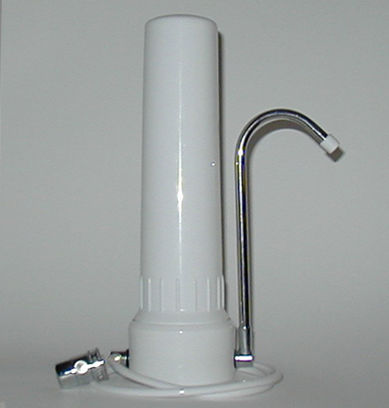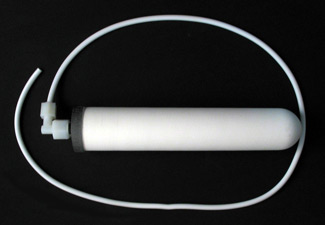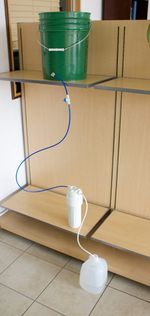How to Have Plenty of Drinking Water in Times of Emergency Without Spending Your Life Savings
To Read This Special Emergency Filter Issue on Our Website
The Pure Water Occasional's Practical Guide to Water Filters for Emergencies
 |
Long Live Laundry BleachIn your effort to assure safe drinking water for y0ur family in times of emergency, you may not have considered that you already have one of the best water purification tools available. If you have a gallon of bleach in your cleaning closet, you have the potential for 3,800 gallons of potable water. What's more, you don't need a hard-to-operate pump or an expensive stainless steel canister to process it. The article below will introduce you to some ideas about emergency water treatment that will work in situations from short-term "boil water" warnings to an extended disaster scenario. It will introduce you to a couple of our simple and inexpensive products and it will also give you other ideas about coping with water emergencies. |
We'll start this overview of emergency filters with a reprint from an Occasional of a couple of years back.
Providing Water for Emergencies
by Gene Franks
Our filter depends on the natural force of siphoning to draw water through the filter. It works by submerging a single Doulton ceramic candle with an attached tube in a container of water, starting a siphoning action by sucking on the tube, then allowing the filtered water to be collected in a container lower than the first. (Illustration and full details.)
A bit later, we developed a variation on the basic ceramic siphon filter, this time using a state-of-the-art carbon block filter cartridge, the Multi-Pure VOC, for which we made a siphoning adapter similar to the one used for the Doulton candle. With this filter standard household bleach is required. Water is purified with bleach (a single gallon of bleach is enough to treat 3,800 gallons of questionable water), then filtered through the NSF-certified Multi-Pure cartridge. (Illustration and details.)
Chlorine has been used by municipalities to make water safe from bacterial contamination since early in the last century. It will still work even if computers fail or if a flood knocks out your city's water supply system. Ceramic filters were invented for the purpose of making the polluted water of the Thames safe to drink. With the help of the principle of siphoning, which has never been known to fail, either chlorine or filtration through ceramic can provide safe water for emergencies even in the absence of electrical power or pressurized water.
A Common Sense Approach to Emergency Water
As indicated in the reprinted article above, we started learning about emergency water treatment during the Y2K madness that swept the nation during the last couple of years of the 20th century.
That period spawned an entire new fear-driven demand for survival equipment, much of it elaborate and expensive. For some time we had been selling Doulton ceramic filter cartridges, not for emergency use but for everyday drinking water in areas where the water was
 |
|---|
Model 77S. In our opinion, the best value ever in an emergency water filter. Buy the Model 77S with a Doulton Super Sterasyl Ceramic Candle as the standard cartridge. Price: $77. Ask for the free siphon adapter. Then add a carbon block replacement filter for $21. Use the carbon block for everyday use and save the ceramic candle and siphon adapter for emergency water. |
unsafe. For example, we had a version of our $77 countertop filter, Model 77, that came standard with a Doulton ceramic candle. It was intended for use of well water customers whose water was contaminated with coliform bacteria.
As the end of the world approached, people began calling us with orders for Doulton cartridges because they were the same cartridges used in a popular $400 four-filter canister product being aggressively marketed as the only way to survive the upcoming cataclysm. We saw that we could make not only a less expensive but a more efficient product using standard parts that we already had. And, in the case of the Model 77, by providing a free siphon adapter we could sell an inexpensive, high quality product for everyday use that could be easily converted to use during emergencies.
Then we made a siphon adapter for the Doulton ceramic candle, the filter cartridge itself, so that people who wanted only an emergency filter could buy the whole thing, cartridge and adapter, for less than $40. Not only did our product produce the same water (exactly) as the $400 unit, it outperformed it significantly in terms of gallons-per-day production. (An interesting discovery we made at the time was that many people were willing to spend hundreds of dollars to provide water for emergencies but were totally unconcerned about the water their families were drinking every day.)
After the world failed to end on schedule, we kept the siphon kit on our website and continue to offer the free siphon adapter for Model 77 to anyone who requests it.
We then started making siphon adapters to fit carbon filters, like the Multi-Pure carbon blocks, and sold them with instructions about how to add chlorine to the water to kill microbes then filter it through the carbon block to remove the chlorine as well as other chemicals. This makes a very effective water filter even for every day use. It's ugly and cumbersome and messy, but it's inexpensive and very effective.
Some things to consider about emergency water treatment:
1. The main objective in emergency treatment is to make the water free of microbial contaminants that cause disease. This means, mainly, bacteria and cysts. Bacteria and cysts can be strained out by ceramic filters and some of the newer filtration devices created for this purpose. Bacteria are also killed with chlorine . That's the way the city water department usually does it. Cysts (Cryptosporidium, Giardia) are not reliably treated with chlorine, but they are physically large (in the relative terms of the micro world) and can be easily strained out by a 1 or 2 micron filter. Even if you chlorinate your water, it's best to send it though a filter tight enough to eliminate cysts. Other bacteria-killing strategies that are sold include iodine tablets, hydrogen peroxide, and liquid oxygen. Chlorine, in the form of laundry bleach, is cheap and available and it seems like the easy way to us.
2. Next come chemicals. Carbon filters remove chemicals. Ceramic filters don't, unless they have a carbon core.
3. Don't waste your time worrying about exotics like fluoride, or Hexavalent Chromium. or "pharmaceuticals." . Certainly don't worry about pH amendment. The idea is to survive the water shortage, not protect yourself against osteoporosis in old age.
 |
|---|
| This simple siphon filter that uses the natural force of gravity to pull water through the tight ceramic cartridge effectively reduces bacteria, cysts and most viruses. It's easy to store, easy to operate, and has a virtually eternal shelf life. It can be purchased with a carbon core, to improve taste and remove chemicals, and it can even be purchased with an add-on inline carbon filter for added chemical capacity. Full details are on our main website. |
4. Many familiar inhabitants of our everyday world don't change during an emergency. Bleach, which cities have used to purify water for decades, will still purify water, and gravity, which has always made water flow downhill, will still pull water downhill. People often forget this. In the worst disasters ever recorded, gravity has never failed to work.
5. Storing water for a short "boil water" episode isn't a bad idea, but water storage is bothersome and space-consuming. Storing enough water for a long-term shortage is not practical.
6. If in an emergency you don't have water from your tap, you'll likely not have electricity or natural gas. Therefore, distillers, ultraviolet purifiers, and reverse osmosis units can't be relied on for emergency water. The best source of energy to power an emergency water treatment device is gravity. Even the old standby of boiling water is hard to carry out if you don't have electricity or natural gas.
7. As noted above, a gallon of bleach has the potential to purify 3,800 gallons of water. Similarly, a gravity drop of only 3 feet can drive water through virtually any conventional water filter, including very tight ceramic filters.
8. Gravity is free and bleach is cheap. You don't need a $400 steel can or a high-tech mini pump to purify water.
9. There are many websites that feature instructions for emergency water purification with bleach. The information sources include the American Red Cross, the Clorox company, and others. These differ in detail, but here's a short version of what they say:
a. Use standard 5.25% to 6%, regular grade bleach. Do not use enhanced or perfumed versions. Do not use dry bleach.
b. Use a couple of drops of standard bleach per quart of water, 8 drops per gallon, half a teaspoon per 5 gallons. Double this if the water isn't clear. Mix well, then let it stand for half an hour. If you can smell bleach in the water after half an hour, it's OK to use it. If you can't smell bleach, repeat the treatment. Some instructions double the amounts given above. Our advice: More is not always better. Avoid the impulse to pour in half a cup of bleach. You'll only create an unusable mess.
Our New Emergency Filter: The Big Bucket
A Work in Progress
Our newest product in emergency water preparation is, as its name implies, a simple device. At present, we're still perfecting it and testing it.
The heart of the system is a "big bucket" (if you think we're making fun of the "Big Burkey" cult, you're right).
The bucket's main function is to hold water and the paraphernalia needed to get water to flow from the big bucket through a water filter.
We put a bulkhead fitting through the side of the bucket near the bottom and attached a small screening filter to the inside of the bucket so that that water leaving the bucket is prefiltered to protect the tight filter below from large particles.
Outside the bucket, there is a swiveling elbow that attaches a length of 1/4" poly tubing. We've inserted an inline valve into the tubing as a convenient way to turn water production on and off.
The final stage is the filter itself. The housing in the picture below is a Watts "Half Turn" housing, but other housings will work. It accepts full-sized 9.75" x 2.75" filter cartridges. This gives the unit lots of possible applications. But the bucket will feed virtually any filter housing (including one you may already own). Any standard-sized housing like the one in the picture will work with virtually any filter cartridge you want to put with it.
It can be used with full-sized bacteria filters like the Doulton Imperial or NanoCeram. Or, with chlorine added to the water being treated, it can use a carbon block filter to remove the chlorine, cysts and any chemicals that are in the water.
Think of the Big Bucket as your own water treatment plant. It serves as the settling tank where large sediment drops out of the water, the prefiltration system for gross particles, the chemical treatment tank where chlorination takes place, and even the water tower, which provides the pressure.
 |
|---|
| The five gallon bucket produces a bit more than 4 gallons per batch. A three-foot plus gravity drop makes it a fast producer. The handle makes it easy to move or allows it to be suspended from a tree or a doorway. |
 |
| A gravity drop of 3-feet or more gives production rates that far exceed those of standard double canister gravity filters. This simple setup works well with very tight filters like ceramics and carbon blocks. |
Don't look for the Big Bucket in a store near you. You'll find it only on our website, and the Occasional will let you know when it's ready.
Pure Water Products
940 382 3814